Fibrin and fibrinogen Study guides, Class notes & Summaries
Looking for the best study guides, study notes and summaries about Fibrin and fibrinogen? On this page you'll find 1244 study documents about Fibrin and fibrinogen.
Page 4 out of 1.244 results
Sort by

-
AAB PER Q&A (Graded A)
- Exam (elaborations) • 17 pages • 2023
- Available in package deal
-
- $13.49
- + learn more
AAB PER Q&A (Graded A) Hemostasis involves all of the following EXCEPT - Ans ️️ -VASODILATION Factor XII is most commonly activated by exposure to which one of the following - Ans ️️ - SUBENDOTHELIUM Which coagulation fmaily is dependent on vitamin K synthesis - Ans ️️ -PROTHROMBIN which of the following factors does not require vitamin K for its production by the liver - Ans ️️ -VIII Which activated coagulation factor is NOT a serine protease - Ans ️️ -VIII What is t...
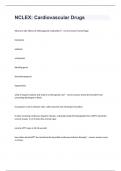
-
NCLEX Cardiovascular Drugs Question and answers already passed
- Exam (elaborations) • 15 pages • 2024
-
Available in package deal
-
- $14.99
- + learn more
NCLEX Cardiovascular Drugs Question and answers already passed NCLEX: Cardiovascular Drugs What are side effects of Anticoagulant medications? - correct answer hemorrhage hematuria epistaxis ecchymosis bleeding gums thrombocytopenia hypotension what is Heparin Sodium and what is its therapeutic use? - correct answer prevents thrombin from converting fibrinogen to fibrin its purpose is not to dissolve clots, rather prevent new thrombus formation if client receivi...
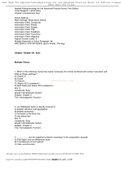
-
Applied Pathophysiology for the Advanced Practice Nurse, First Edition Lucie Dlugasch, Lachel Story Chapter 3 Assessment Quiz
- Exam (elaborations) • 7 pages • 2022
-
- $11.49
- 2x sold
- + learn more
Chapter: Chapter 03 - Quiz Multiple Choice 1. Which of the following coenzymes is(are) necessary for normal red blood cell nuclear maturation and DNA synthesis pathway? A) Vitamin D B) Folate C) Calcium D) Vitamin B12 (cobalamin) E) Both folate and vitamin B12 (cobalamin) Ans: E Complexity: Easy Ahead: Hematopoietic System Subject: Chapter 3 Title: Hematopoietic Function 2. von Willebrand factor is directly involved in: A) platelet adhesion and aggregation. B) platelet production...
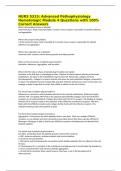
-
NURS 5315: Advanced Pathophysiology Hematologic Module 4 Questions with 100% Correct Answers
- Exam (elaborations) • 16 pages • 2024
-
- $12.49
- + learn more
NURS 5315: Advanced Pathophysiology Hematologic Module 4 Questions with 100% Correct Answers What is the peripheral zone of platelet? Outermost layer. Made of phospholipids. Contains many receptors responsible for platelet adhesion and aggregation What is the sol-gel of the platelet It is the outermost layer made of possible if it contains many receptors responsible for platelet adhesion and aggregation What is the organelle zone of platelets Innermost layer contains calcium dense ...
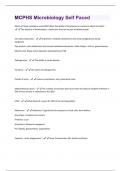
-
MCPHS Microbiology Self Paced Questions and Answers Latest 2024/2025 with complete solutions
- Exam (elaborations) • 26 pages • 2024
- Available in package deal
-
- $7.99
- + learn more
Which of these conditions would NOT affect the ability of Streptococcus mutans to attach to teeth? - The absence of Actinomyces, a bacterium that can be part of dental plaque cell wall components - M proteins: mediates attachment and resists phagocytosis (strep. pyogenes) Opa protein: assist attachment and recept mediated endocytosis, inhibs helper t cells (n. gonorrhoeae) Mycolic acid: Waxy, resists digestion (mycobacterium TB) Pathogenicity - The ability to cause disease Virulence - the...
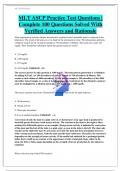
-
MLT ASCP Practice Test Questions | Complete 100 Questions Solved With Verified Answers and Rationale
- Exam (elaborations) • 35 pages • 2024
- Available in package deal
-
- $13.00
- + learn more
MLT ASCP Practice Test Questions | Complete 100 Questions Solved With Verified Answers and Rationale After experiencing extreme fatigue and polyuria, a patient's basic metabolic panel is analyzed in the laboratory. The result of the glucose is too high for the instrument to read. The laboratorian performs a dilution using 0.25 mL of patient sample to 750 microliters of diluent. The result now reads 325 mg/dL. How should the techologist report this patient's glucose result? A. 325 mg/dL B...
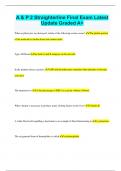
-
A & P 2 Straighterline Final Exam Latest Update Graded A+
- Exam (elaborations) • 56 pages • 2024
-
- $12.99
- + learn more
When erythrocytes are destroyed, which of the following events occurs? The globin portion of the molecule is broken down into amino acids. Type AB blood has both A and B antigens on the red cells In the platelet release reaction, ADP and thromboxanes stimulate other platelets to become activated. The hematocrit is d. the percentage of RBCs in a given volume of blood. What vitamin is necessary to produce many clotting factors in the liver? Vitamin K A white blood cell engulfing a bacterium...
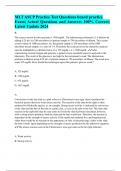
-
MLT ASCP Practice Test Questions board practice Exam| Actual Questions and Answers 100% Correct| Latest Update 2024
- Exam (elaborations) • 42 pages • 2024
-
- $10.99
- + learn more
B; The correct answer for this question is 1300 mg/dL. The laboratorian performed a 1:4 dilution by adding 0.25 mL (or 250 microliters) of patient sample to 750 microliters of diluent. This creates a total volume of 1000 microliters. So, the patient sample is 250 microliters of the 1000 microliter mixed sample, or a ratio of 1:4. Therefore, the result given by the chemistry analyzer must be multiplied by a dilution factor of 4. 325 mg/dL x 4 = 1300 mg/dL. After experiencing extreme fatigue...
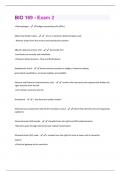
-
BIO 169 - Exam 2 Questions And Answers
- Exam (elaborations) • 22 pages • 2024
- Available in package deal
-
- $7.99
- + learn more
• Macrophages - Antigen-presenting cells (APCs) Abdominal lymph nodes - - Occur in posterior abdominopelvic wall - Monitor lymph from the urinary and reproductive systems Albumin (plasma protein 1/3) - -formed by liver -contributes to viscosity and osmolarity -influences blood pressure , flow, and fluid balance Anaphylactic shock - Severe immune reaction to antigen, histamine release, generalized vasodilation, increased capillary permeability Anterior and Posterior Interventricular sul...
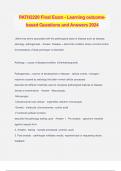
-
PATH2220 Final Exam - Learning outcome- based Questions and Answers 2024
- Exam (elaborations) • 95 pages • 2024
-
- $14.49
- + learn more
PATH2220 Final Exam - Learning outcome- based Questions and Answers 2024 define key terms associated with the pathological basis of disease such as disease, aetiology, pathogenesis - Answer- Disease = abnormal condition where normal function (homeostasis) of body part/organ is disturbed Aetiology = cause of disease/condition (inherited/acquired) Pathogenesis = manner of development of disease - cellular events / changes / reactions caused by aetiology that alter normal cellular processes ...

How much did you already spend on Stuvia? Imagine there are plenty more of you out there paying for study notes, but this time YOU are the seller. Ka-ching! Discover all about earning on Stuvia


